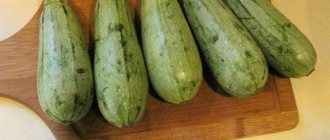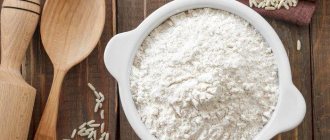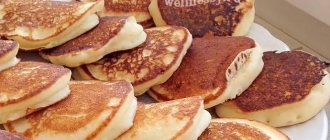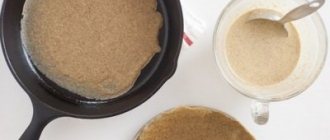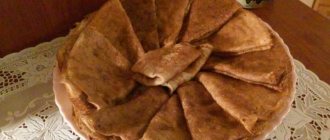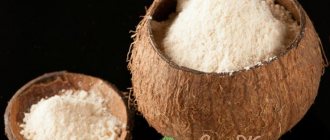Since not only wheat flour became freely available, housewives have not tired of experimenting with baking. A huge variety of interesting recipes have been developed for buckwheat, oatmeal, barley, corn and even flaxseed flour. Some chefs have completely abandoned the use of traditional ones. But spelled flour turned out to be somewhat outside the bounds of general attention. However, you can’t buy it in all supermarkets. Meanwhile, if you still try spelled flour in culinary delights, you can easily switch to using it only.
Spelled flour: benefits
Spelled is an ancient variety of wheat. It is resistant to weather vagaries, diseases, pests, but is less productive than modern varieties. In addition, it is much less easy to grind. This is precisely the reason for its gradual displacement by new competitors: now the plant occupies a negligibly small sown area, although recently there has been a tendency to increase it.
At the same time, spelled flour does not have the disadvantages of wheat flour and has significant advantages. It contains as many as 18 amino acids and a set of vitamins, including relatively rare ones. The vegetable protein content in it is very high, and it is easily digestible. Of the beneficial elements, it is especially notable for the presence of magnesium and iron, and a number of nutritionists even attribute medicinal qualities to it. There is another attractive feature that spelled flour can boast of: you can use the same recipes that use wheat flour, but the result will be more tender, with dense pulp and a unique aroma.
What is spelled flour
Spelled flour is an ancient relative, the “great-grandmother” of wheat, but... not touched by the science of the laws of heredity. Many people confuse spelt with spelt, which has never been grown in Russia. But spelled has been grown in Rus' since time immemorial. The Latin name is Triticum dicoccum, and spelled is Triticum spelta. Outwardly they are similar, but through the eyes of a botanist these are two ancestors of wheat, not changed by people, not affected by mineral fertilizers, but different species! So if you are looking for truly environmentally friendly products of domestic production, then you have come to the right place. Let's get acquainted with whole grain spelled flour - the healthiest, grown not somewhere in the south of Europe like its relative spelled, but in Russia.
Preparation
- 300 grams of flour are sifted with a spoon of salt.
- A spoonful of dry milk, two spoons of brown sugar and a spoonful of dry yeast are added to the mixture.
- After stirring, pour in a partial glass of warm water.
- The dough is first mixed with a wooden spoon, and then with your hands, until it stops sticking to the bowl.
- The lump is laid out on a floured board and kneaded for ten minutes until soft and elastic.
- The container is greased with oil, a ball of dough is placed in it, covered with film and hidden at the bottom of the refrigerator overnight.
- In the morning, the dough is kneaded into a rectangle according to the size of the mold, again wrapped in film and left in the mold for half an hour. After the film is removed, the mold is coated, the dough is returned to the mold and placed in the oven.
The bread is baked for half an hour, cooled on a wire rack and only then removed from the mold.
How to make “Carrot bread with spelled flour”
Prepare the starter and biga in advance in different dishes, in the first mix flour and warm water, and in the second - yeast, warm water and flour. Cover with film and place in a dark place at room temperature overnight.
Mix the starter and biga, add grated carrots, knead the dough.
Add the rest of the ingredients and knead the dough.
Knead the risen dough and divide it into 4 equal parts. Grease the baking dish generously with butter and sprinkle with flour.
Roll each part into a rectangular layer no wider than the width of the mold, and roll it into a roll.
Dip the top side of the rolls with poppy seeds or semolina.
Place the loaves in the pan with the seam facing down. Cover again with film and leave in a warm place to proof for another 1 hour.
Bake in an oven preheated to 220°C for about 45 minutes. Cool on a wire rack.
Delicious pancakes
The best test of an unfamiliar flour is to try making pancakes with it. If they succeed, it can be safely used in any baking. We are absolutely confident about pancakes made from spelled flour: they turn out airy, and even with a tempting nutty smell. The dough is prepared simply. Sift 150 grams of spelled flour into a bowl - this is about two-thirds of a glass. A glass of kefir and half a glass of milk plus two egg yolks and a little salt are poured into the hole. The dough is processed with a mixer until lumps are completely eliminated and left to “rest” for a quarter of an hour. Pancakes are baked in a completely standard way. And they taste better by spreading them with jam, rolling them into a tube and dusting them with powdered sugar.
Ingredients for spelled flour cake with cherries and blueberries
- 1.5 cup or a little more spelled flour;
- 3 medium eggs;
- 3/4 cup (150 g) sugar;
- 1 cup (200 ml) sour cream;
- 70 g butter;
- 1.5 tsp. baking powder;
- on the tip of a teaspoon - baking soda;
- 1/4 tsp. salt;
- 50 g chocolate;
- 1/3 cup pitted cherries;
- 1/3 cup blueberries.
The volume of the glass is 200 ml. Berries can be taken frozen or fresh. It is more convenient to use chocolate in the form of crumbs or droplets, but you can also break the bar into small pieces.
For glaze and topping:
- 50 g chocolate;
- 1 tbsp. l. odorless vegetable oil;
- chopped nuts.
You can use dark or milk chocolate for the glaze. Nuts - walnuts, hazelnuts, cashews or almonds, or an assortment of different types.
Ingredients for making spelled flour cake with cherries and blueberries
Tempting spelled pie
If you have children, they will surely love this dessert. And adults won’t refuse a piece or two for tea. Preparation does not take much time, and the pleasure is great.
First, prepare the dough: a 70-gram piece of butter is grated on a coarse grater and mixed with a third of a spoon of soda and flour. Naturally, spelled flour, about half a glass. The final consistency resembles breadcrumbs.
Next, the filling is made: a pack of cottage cheese of any fat content is ground with two eggs and four tablespoons of sugar. At the same time, a large apple is peeled, seeds removed and thinly sliced.
The pie is assembled: the pan, lined and greased, is laid out with most of the dough. The curd filling is poured into the resulting “basket”, apple slices are laid out on top and sprinkled with the rest of the dough. This joy bakes for about 20 minutes; When ready, you can sprinkle it with powdered sugar.
Indications for use
People are advised to consume this variety of cereal:
- with weakened immunity;
- those prone to excess weight and obese patients;
- elderly;
- suffering from frequent, including acute, respiratory diseases;
- with diabetes mellitus;
- with constant mental and physical stress and chronic overwork, fatigue;
- in case of disruption of normal bowel function;
- with high blood pressure;
- during pregnancy.
Honey cake for the post
In anticipation of the days of food restrictions, housewives are stocking up on interesting recipes designed to brighten up the prescribed food deprivations. And spelled flour will come in very handy here, from which you can bake a lot of all sorts of goodies. In particular, a cupcake that will delight you even on those days when you no longer need to fast. First, three and a half tablespoons of sugar and a spoonful of natural honey are diluted in half a glass of water. You can even take it candied, you just have to wait longer. The next step is to sift a quarter kilogram of flour into a bowl, with constant kneading so that the spelled flour does not form lumps. The last step is to pour in half a glass of vegetable oil and knead it. The dough is poured into the mold in which the cupcakes are baked. It is placed in the oven for only a third of an hour. And you have a crumbly, fragrant and very tasty dessert for tea.
Cereal soup recipe
- turkey - 500 gr;
- spelled - 50 g;
- carrots, green bell peppers and onions - 1 unit each;
- salt - ½ tbsp. l. (adjust according to taste preferences);
- pepper mixture - a pinch;
- garlic - 1 clove;
- tomatoes - 3 fruits;
- cauliflower - 100 g;
- drain butter - 30 g;
- greens optional;
- water - 1.3-1.5 l.
First, prepare the broth: rinse the turkey and put it in water. From the moment of boiling, cook for a third of an hour, not forgetting to collect the foam, otherwise the broth will turn out cloudy. Let the meat cool, then separate it into portions and put it back into the broth.
Next, prepare the vegetables: chop the onion and garlic and simmer in hot oil in a saucepan. In the meantime, cut the carrots into quarters, the peppers into cubes, simply separate the cabbage into inflorescences, peel the tomatoes and divide them into cubes. Gradually, as you prepare the vegetables, add them to the saucepan to sauté, stirring occasionally.
Let the vegetables simmer for a few more minutes together, adding salt and seasoning, meanwhile washing the spelled. Add the cereal to the vegetables, cook for another five minutes, and add to the broth with the meat. Bring the soup to a boil, cook for about five minutes, add chopped herbs, and after a couple of minutes turn off the heat. Leave covered for a third of an hour.
Description
This wonderful grain crop has been growing on our planet for more than 7,000 years, it has many names, it is not afraid of bad weather, weeds and pests, and it itself does not accept artificial fertilizers, remaining as wild and free (and therefore useful!) as and BC, when the first Neanderthals collected its grains!
Did you guess it? Now I will introduce you! This is wild wheat; The English have spelled, the Slavs have spelled, the Italians have farro, the Germans have dinkel - that’s how many beautiful names it has. This oldest variety of wheat is a cereal from fairy tales, myths, legends and traditions, which was eaten by the Scythians and Hellenes, the ancient Romans and Egyptians. There are eight varieties of spelled, which differ slightly in ear structure and grain size; What unites all types is the main difference from soft, ordinary wheat: immunity to the “benefits of civilization” in the form of chemical agricultural products and grains, dressed in dense “scales”. Spelled is difficult to thresh; grains are threshed only together with flower and spikelet scales. There is not much grain, but this is compensated by the unpretentiousness of the plant, an unusually strong and hardy crop. I read somewhere that spelled not only is not afraid of weeds, but kills weeds itself, that’s how it is! But with the advent of progress, spelled began to be sown less and less, giving preference to soft wheat, which is more productive and easier to process, and, more recently, durum wheat. There are few spelled crops left in the world, which is why flour made from it is highly valued. But spelled flour is worth it - as the most natural and environmentally friendly, it is very valuable and very tasty!
Baked goods made from spelled flour have a pleasant beige hue and a wonderful taste, slightly sweet, like baked goods, delicate with a nutty undertone. And you can bake anything from spelled - just like from regular wheat: bread, muffins, pies, amazingly delicious pancakes and pancakes! Any baked goods made with wild wheat become much tastier and much healthier. That’s why we’ll give preference to spelled – we’ll try to bake different goodies from it! For example, bread. My first baked product using spelled flour was homemade poppy seed bread. Very tasty, try it! Thanks to Tanyusha for the idea of adding poppy seeds to the bread - it’s very original and tasty, healthy and beautiful!
And I thank site reader Olga for introducing me to amazing wheat!!!

